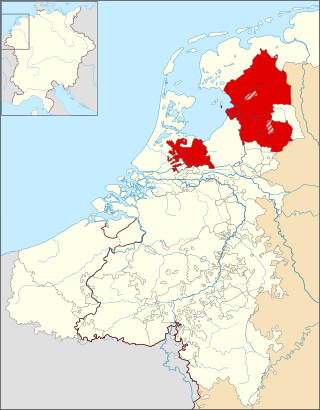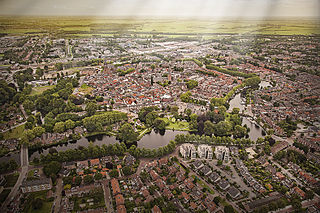
Year 1156 (MCLVI) was a leap year starting on Sunday of the Julian calendar.

The Bishopric of Utrecht was an ecclesiastical principality of the Holy Roman Empire in the Low Countries, in the present-day Netherlands. From 1024 to 1528, as one of the prince-bishoprics of the Holy Roman Empire, it was ruled by the bishops of Utrecht.

The House of Zähringen was a dynasty of Swabian nobility. The family's name derived from Zähringen Castle near Freiburg im Breisgau. The Zähringer in the 12th century used the title of Duke of Zähringen, in compensation for having conceded the title of Duke of Swabia to the Staufer in 1098. The Zähringer were granted the special title of Rector of Burgundy in 1127, and they continued to use both titles until the extinction of the ducal line in 1218.

Woerden is a city and a municipality in central Netherlands. Due to its central location between Amsterdam, Rotterdam, The Hague, and Utrecht, and the fact that it has rail and road connections to those cities, it is a popular town for commuters who work in those cities.
Dirk VI was Count of Holland between 1121 and 1157, at first, during his minority, under the regency of his mother Petronilla. He was the son of Count Floris II. After his death he was succeeded by his eldest son Floris III. He married Sofie of Salm, Countess of Rheineck and Bentheim. She was heiress of Bentheim, which she ruled together with her husband and which was inherited by the couple's second son Otto after his parents' death.
The County of Verdun was a sovereign medieval county in the Duchy of Lower Lorraine.
Friedrich II of Berg, was Archbishop of Cologne from 1156 until his death in 1158.
Otto I of Guelders (1150–1207) was a Count of Guelders and Zutphen from 1182 until his death in 1207. He was a son of Duke Hendrik of Guelders and Agnes of Arnstein. He married Richardis of Bavaria in 1184. Richardis was a daughter of Otto I Wittelsbach, Duke of Bavaria.
Henry I, Count of Guelders (1117–1182) was Count of Guelders from 1131 until 1182. He was a son of Gerard II of Guelders and Ermgard of Zutphen.
Herman II, Lord of Lippe was a ruling Lord of Lippe.
Godfried or Godfrey van Rhenen was a bishop of Utrecht from 1156 to 1178.

Arnold IV of Loon (Looz) (died between November 1272 and October 1273; most likely on February 22, 1273), was Count of Loon from 1227 to 1273 and Count of Chiny (as Arnold II) from 1228 to 1268. He was the son of Gérard III, Count of Rieneck and Cunegonde von Zimmern.
Henry I, Count of Tecklenburg was a German nobleman. He was the ruling Count of Tecklenburg from c. 1150 until his death.
Herman II, Count of Winzenburg was a son of Herman I, Count of Winzenburg and his second wife, Hedwig. She was either Hedwig of Assel-Woltingerode or Hedwig of Carniola-Istria. Herman II succeeded his father as Count of Winzenburg, without achieving the dominant position his father had held. He was a loyal supporter of Archbishop Adalbert of Mainz for many years.
The historic Diocese of Utrecht was a diocese of the Latin Church of the Catholic Church from 695 to 1580, and from 1559 archdiocese in the Low Countries before and during the Protestant Reformation.
The counts of Chiny were part of the nobility of Lotharingia that ruled from the 9th to the 14th century in what is now part of Belgium.
Otto II, Count of Chiny, son of Arnold I, Count of Chiny, and Adélaïs.
Godfrey de Heinsberg, Lord of Daelenbroeck, Count of Looz and Count of Chiny (1361–1362), son of John of Heinsberg, Lord of Daelenbroeck.




